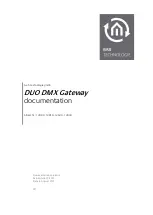
36
ICC
database operation can be used for this purpose, such a scenario may most
typically use the output of a “compare” operation in order to control whether or
not other operations should execute (e.g. execute a certain operation only when
some process variable is greater than a certain value, etc.) Allowing the
conditional execution of database logic operations to be based on data values
obtained via communications or as a result of other database logic operations
enables the construction of flexible, hierarchical and dynamic data evaluation and
manipulation engines.
Enable Value Database Address
Enter the database address which specifies the byte-size trigger value.
8.3.2.3.1 Trigger Options
The enable trigger can perform basic logic on the enable value to determine if an
operation should execute using a variety of trigger options. These setting
determine what logic should be applied to the enable value when evaluating
whether or not the operation should execute.
Inverted
Specifies whether the enable logic should be inverted. This applies to both the
evaluation of whether or not the operation should execute as well as resetting the
enable value when the auto reset option is used.
Auto Reset
Allows the enable value to be automatically reset upon completion of the
operation. The actual value written to the enable value depends on the other
trigger options selected. If no options are selected, a value of 0 is written to the
enable value. If the inverted option is used, a value of 1 is written to the enable
value. If the bitmask option is used, each bit selected in the bitmask is written to
a 0 (or a 1 if the inverted option is used) in the enable value.
Bitmask
If this option is used, it selects which bits in the enable value to evaluate. Every
selected bit in the enable value must be 1 (or 0 when the inverted option is used)
for the operation to execute.
8.4
Service Objects and Diagnostics Objects
A service object is used by the gateway to make requests on a network when a
master/client protocol is enabled. Each service object defines the services (read
and/or write) that should be performed on a range of network objects of a
common type. The data from read requests is mirrored in the database starting at
a user-defined address (if a read function is enabled). When a value within that
address range in the database changes, a write request is generated on the
network (if a write function is enabled). Specific service object configuration
depends on the protocol selected: refer to the protocol-specific section of this
manual for further details.
















































